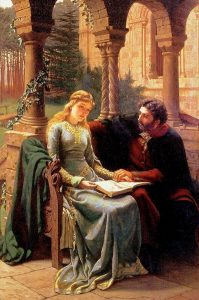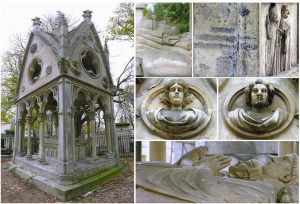|Famous French Couples|
Love story in Paris : A passion transformed into an unbreakable link – The grave of Héloïse and Abélard is located at the Père Lachaise Cemetery, Paris 20th district, with lots of famous people such as Edith Piaf, Frédéric Chopin, La Fontaine, Molière, Oscar Wilde, Maria Callas, Jim Morrison, …
Greatest love stories associated with Paris
1. Héloïse and Abélard (12th Century)
Perhaps Paris’s most famous tragic love story. Peter Abélard, a brilliant philosopher, and Héloïse, a gifted scholar, fell in love despite the strict rules of the Church. Their secret affair led to scandal, a child, and eventual separation, but their passionate letters remain a testament to eternal love.
2. Napoleon and Joséphine (Late 18th – Early 19th Century)
The powerful and complicated romance between Napoleon Bonaparte and Joséphine de Beauharnais defined an era. Despite his deep love for her, Napoleon eventually divorced Joséphine due to her inability to bear him an heir, though he reportedly whispered her name with his last breath.
3. Victor Hugo and Juliette Drouet Love story in Paris (19th Century)
The famous author of Les Misérables had a long and passionate affair with Juliette Drouet, a former actress. She became his devoted companion, writing him thousands of letters and following him into exile, standing by his side for nearly 50 years.
4. Edith Piaf and Marcel Cerdan (Mid-20th Century)
The iconic French singer and the world champion boxer shared a whirlwind romance cut short by tragedy when Cerdan died in a plane crash. Piaf’s grief inspired one of her most famous love songs, Hymne à l’Amour.
5. Jean-Paul Sartre and Simone de Beauvoir (20th Century)
The existentialist philosophers shared a lifelong open relationship built on intellectual and emotional companionship. Their unconventional love challenged norms and helped define Paris as a hub of intellectual and romantic freedom.
6. Serge Gainsbourg and Jane Birkin (1960s–1980s)
Their stormy yet iconic relationship symbolized the bohemian and provocative spirit of Paris in the 60s and 70s. Their duet Je t’aime… moi non plus remains a sultry anthem of passion and rebellion.
7. François Mitterrand and Anne Pingeot Love story in Paris (Late 20th Century)
The French President kept a secret love affair with art historian Anne Pingeot for decades. Their relationship, and the daughter they shared, was revealed in 1994 to the public before his death in 1996, adding a romantic twist to French political history.
8. Emmanuel and Brigitte Macron (21st Century)
One of the most talked-about modern Parisian love stories. Despite a 24-year age gap and early controversy, their enduring marriage and mutual support have captured global attention, reflecting a new kind of modern love in France.
9. George Sand and Alfred de Musset (1830s)
The novelist George Sand (real name Aurore Dupin) and the young poet Alfred de Musset shared a turbulent and fiery affair that began in Paris and continued in Venice. Their romance was full of passion, jealousy, and creative inspiration. Both wrote about their love in veiled (and sometimes not-so-veiled) literary works. Their affair is remembered as one of the most dramatic literary romances of 19th-century France.
10. Voltaire and Émilie du Châtelet (1730s–1740s)
The brilliant philosopher Voltaire and the mathematician and physicist Émilie du Châtelet formed an extraordinary intellectual and romantic partnership. Living together at her château in Cirey-sur-Blaise (while keeping a Parisian social presence), they collaborated on scientific experiments and translations, most notably Émilie’s French translation of Newton’s Principia. Their relationship combined deep affection with a shared passion for Enlightenment thinking.

The greatest and scandalous Love story in Paris
Beginning of Heloise and Abelard love story in Paris
It began in 12th-century, Pierre Abélard , a brainy philosopher and Christian theologian, was employed as a tutor by Héloïse’s uncle, named Fulbert a Canon, a member of Notre Dame subject to an ecclesiastical rule. After a brilliant youth, devoted entirely to study, “became an undisputed king in the domain of dialectics, Abelard entered, as if in triumph, the chair of Paris, to which his destiny led has been calling for a long time. Poet and musician, singing with taste the verses he wrote with art, to the glory of the philosopher he united that of the artist; his fame had spread beyond the School; it had reached the ears of the crowd. He was barely 38 years old, and he seemed to have exhausted all the ambitions of the mind. It was then that, with a calm decision, he would have sought the only satisfactions he did not yet know, the satisfactions of love.
Héloïse a rare distinction of intelligence
So, his pupil was Héloïse d’Argenteuil, a brilliant student. Without being gifted with remarkable beauty, Héloïse did not lack charm. A rare distinction of intelligence promised to add the most exquisite pleasures of the mind. According to Abelard, Héloïse, in addition to Latin, knew Greek and Hebrew. By this we must undoubtedly mean that she understood the words of Greek and Hebrew which most ordinarily brought before her eyes the study of theology. Her taste for study would serve to form the bond. No woman, however, could refuse Abelard’s wishes. Héloïse and Abélard loved each other on the island of île de la Cité, 9-11, quai aux Fleurs, under the reign of King Louis Vl, around 1200. At that time, Abélard was teaching at Notre Dame de Paris. From this union, they had a son. Taking advantage of Fulbert’s absence, Abelard convinced her to flee, dressed as a nun, and she sought asylum with her sister in Brittany, where she gave birth to Astrolabe. Abelard remained in Paris. He had sacrificed everything to her : work, teaching, fame. Indeed, at that time, Christian theologian did not have the right to get married.
A secret marriage love story in Paris
Abelard determined to offer Fulbert the reparation due to him. He will agree to marry the woman he has seduced, provided that his reputation does not suffer, that is to say, on the condition that the marriage remains secret. Despite the mystery with which he had surrounded her, their secret union had soon become known. Transported with anger, Abelard locked Héloïse in Argenteuil Abbey. At this news, Fulbert lost all measure. The scandal of their relationship finally erupts when Héloïse’s uncle, the furious Canon Fulbert denounces their secret and harmful marriage to the career of Abélard. Indeed, Abélard did not respect the law by getting married as a cleric who was already engaged in the ecclesiastical state, according to the laws of this time. In addition, It was also clear that, his passion was beginning to cool, and that he was eager to freely resume his life of study, teaching and argument. Héloïse’s uncle, Fulbert then employs 2 henchmen to punish Abélard. He will be emasculated, deprived of his reproductive organs.
Abélard’s passion for theology
The 2 lovers embrace monastic life, she at the Argenteuil convent, he in Saint-Denis. More than ten years passed then, ten years of indifference and forgetting. The passion for the philosophical struggle had completely taken hold of him. Abelard had returned to the arena, where he was to find the two most formidable adversaries of the century, Norbert of Chartres and Saint Bernard. His new profession made theological teaching a duty for him. Removed from the abbey of Saint-Denis where he had first found asylum; condemned for the boldness of his proposals on the Trinity by the Council of Soissons; forced to throw his book into the fire with his own hand, and relegated to the cloister of Saint-Médard; shortly after returned to Saint-Denis.
Believing himself to be the target of persecution from the whole world, he ended up flee to Champagne, to Count Thibaut’s land. There, his fame had, in a short time, gathered the crowd around his thatched oratory and his grass pulpit. The disciples arrived from all sides, abandoning towns and castles. But soon his aggressive confidence and the name of Paraclete given to the temple he had founded, had awakened the enmities of his adversaries.
The start of the love story in Paris correspondence
In the meantime, the abbot of Saint-Denis had, following serious disorders, claimed the abbey of Argenteuil as an annex formerly subject to his jurisdiction, and expelled the community of which Héloïse had become prioress. It was then that Abelard turned his thoughts towards her. He invited her to settle at the Paraclete with her nuns, and gave it to her. This is the start of the correspondence, letters between the 2 of them.
“To her master or rather to her father; to her husband, or rather to her brother; her servant, or rather his daughter; his wife, or rather his sister; to Abelard, Héloïse. »
From carnal love to the love of Christ, the adventure of Héloïse and Abelard is traced in the correspondence exchanged by the two lovers. A fascinating and enigmatic document. Fiery of the senses, intoxication of the imagination, rapture of the soul, never has passion been described with more penetrating energy. They have embodied romantic love, which knows no obstacles, and they remained a case study for the Catholic Church.
“I call God to witness, if Augustus himself, the master of the world, had judged me worthy of the honor of being his wife and forever assured of the empire of the Universe, I would have found gentler and more worthy to be called your whore rather than his empress”,
writes Héloïse (c. 1100-1164) in letter II of her correspondence with Pierre Abélard (1079-1142), the husband of whom she is from now on separated. Abélard and Héloise suffered for each other within an outstanding passion, not only joy but pain, not only self-realization but self-abandonment to God and to each other.
Intellectual and spiritual love story in Paris
Héloïse started the first monastic order
Despite the ties that invincibly attach her to Abelard, the court of Rome blessed her, and the Rule, imbued with a free and wise spirit, which she had given to the Paraclete, became the basis of the constitutions of all women’s monasteries of its time. Héloïse started the first monastic order with a specifically feminine rule. The Gregorian reform worked to ensure that it does not survive and that the nuns do not become « femmes savantes » (learned women) anymore, but failed in the end. Héloïse is accorded an important place in French literary history and in the development of feminist representation. She was a French nun, writer, scholar, abbess and spouse.
Abelard an outstanding dialectician
Pierre Abelard is probably the best-known French philosophical figure of the 12th century. An outstanding dialectician, Abelard devotes the most substantial part of his work to problems which, today, would be classified as belonging to the fields of logic, the philosophy of language or metaphysics. Abelard has the glory of having, one of the first, introduced the rules of dialectic into theology and claimed, in morality, the rights of reason: he is a precursor of Descartes. Abélard was an excellent philosopher, dialectician and Christian theologian, father of scholasticism and inventor of conceptualism. Abélard passed away in 1142, 22 years before Héloïse. Among his dialectical works, the most substantial are the Logica “Ingredientibus” and the Dialectica, which consist of commentaries on the texts of the Logica Vetus.
-
Abelard Dialectics
Pierre Abelard’s tool is dialectics, which leads him into a work on the word, the verb and the logic of propositions. Such teaching has been based, since Antiquity, on the practice of dialogue and discretion which serve reason and are therefore the virtues par excellence of the pedagogue. Indeed, dialectics, at the time of Abelard, is a much broader field than that which is covered by our current acceptance of the term. For him, philosophy is divided into three major fields, namely physics, ethics, and dialectics. According to him, logic consists in the examination of the validity of arguments, of what makes them “weak” or, on the contrary, “strong”.
-
Abelard Trinity questions
Abelard’s theological writings, for their part, are largely devoted to the question of the trinity, notably the Theologia “summi boni”, the Theologia Christiana and the Theologia “scholarium”. As we mentioned previously, it is the first of these which will be the subject of an accusation of heresy at the Council of Soissons, while it is probably the last which will earn him his accusation at the Council of Sense. Another major contribution of Abelard to theology is his Sic et Non, in which he examines 158 questions.
-
Abelard Regarding ethics
Abelard wrote two main works. His Ethica, also called Scito teipsum, focuses on determining the criteria for judging the good or bad character of the actions of a moral agent. He therefore defines the concepts of good and evil, but also elaborates, within the framework of his intentionalist ethics, the notions of will, consent of the soul to vice, and contempt or respect towards God. In the Collationes, or Dialogue of a Philosopher with a Jew and a Christian, Abelard focuses primarily on the question of the nature of good and happiness, but he also examines questions related to religious commandments.
The doctrine of intent from Abelard
This doctrine is based on the notion that actions are morally indifferent and that only the actor’s intent, determined by his consent to evil, should be weighed in determining sin.
The doctrine of intention, has normally been understood as a moral position adopted by both Héloïse and Abélard, equally. The only uncertainty is in the question of which of the two inspired the other. Indeed, the similarities between the Ethics and Héloïse’s personal letters on intention are quite obvious. It must be admitted, however, that Abelard alone is recognized by posterity as the author of this theological doctrine, apart from the testimony of Héloïse in the correspondence. The very existence of Abelard’s Ethics (1138/39), an astonishing, but generally reasonable and coherent, philosophical investigation into the nature of sin, strongly suggests that the formulation of the doctrine in this text is the creation of Abelard.
Saint Thomas Aquinas begins by resituating the problem of the moral objectivity of the act as it has arisen in history (notably since Abelard) and found its most careful elaboration in the moral philosophy from the Doctor angelic, Saint Thomas d’Aquin.
“There is no crime or offense without the intention to commit it.”
In Law, intention is the will directed towards a goal of which the author knows the illicit nature, and in principle constitutes one of the components of the majority of offenses. The judge takes great care to note this intention in each action of the criminal.

Funerary monument
The funerary monument of Héloïse and Abelard love story is a remarkable funerary monument in the Père-Lachaise cemetery (20th arrondissement of Paris). The ashes of this couple of medieval intellectuals have had several destinations throughout history. First, the Saint-Marcel priory (1142), the Paraclet abbey (1142-1792), the Saint-Laurent church in Nogent-sur -Seine (1792-1800), the Museum of French Monuments in Paris (1800-1817) and finally the Père-Lachaise cemetery (since 1817).
They loved each other too much: they were unhappy;
Let us moan at their graves, and not love like them
On April 23, 1800, the founder of the Museum of French Monuments, Alexandre Lenoir, obtained authorization from the Minister of the Interior Lucien Bonaparte to transfer these remains to Paris. Alexandre Lenoir begins to design a funerary monument worthy enough to accommodate the remaining ashes. It is a neo-Gothic building open to the outside, covering a tomb surmounted by two recumbent figures. The mausoleum is fabricated rather than reconstructed. After a mass in the Saint-Germain-des-Prés church, the two coffins were transferred on June 16, 1817 to the cemetery. First stored in a room then, once the reconstruction of the tomb was completed, in its heart on November 8 following. The monument was blessed then sealed.
Love story in Paris
One of the most romantic things to do in Paris is to discover the story of Abélard and Héloïse in Ménilmontant Belleville district. They rest in peace together at the cemetery du Père Lachaise. Their love story in Paris remains still extraordinary.
Have a private tour guide in Paris. We set your tours upon your preferences. Each trip is unique, according the profile and aspirations of each client.
Emy,

